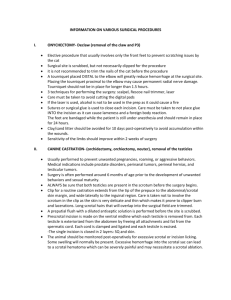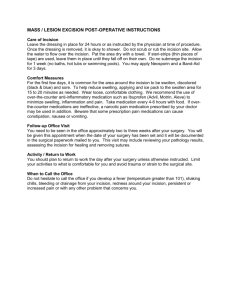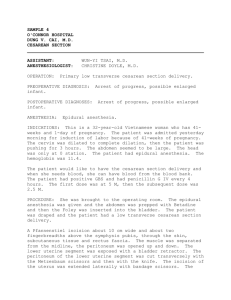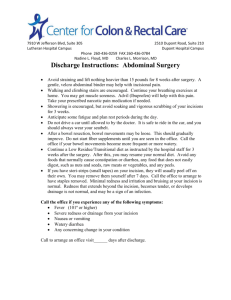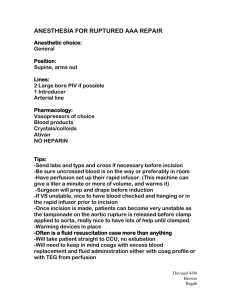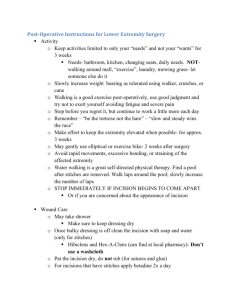SURGICAL PROCEDURES ONYCHECTOMY
advertisement
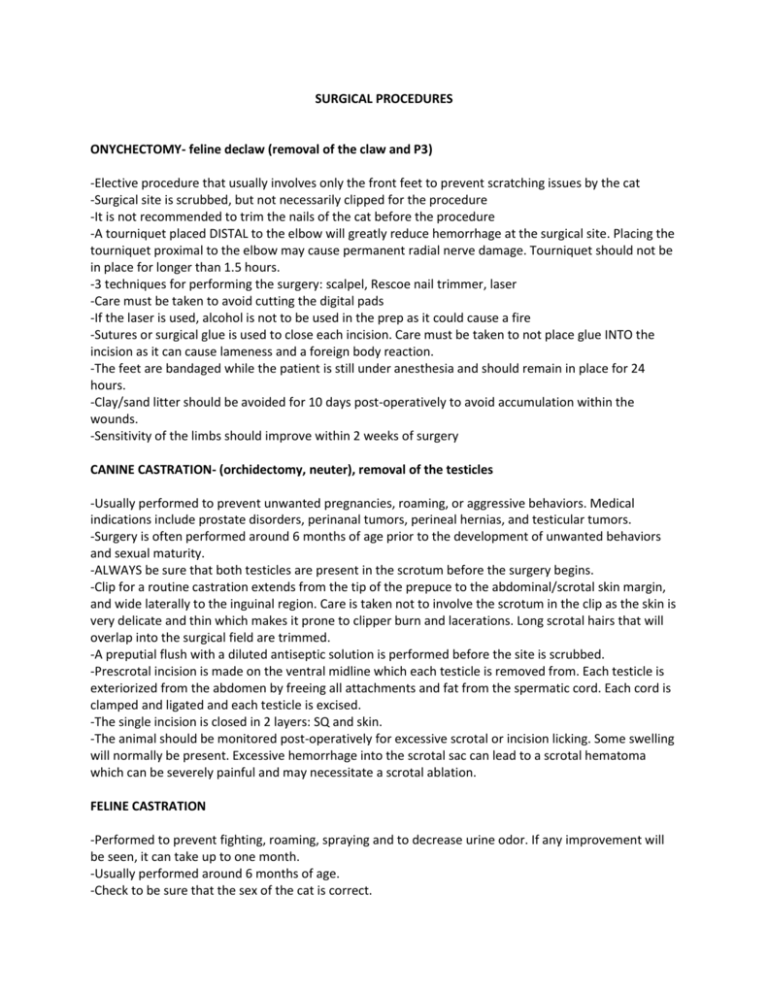
SURGICAL PROCEDURES ONYCHECTOMY- feline declaw (removal of the claw and P3) -Elective procedure that usually involves only the front feet to prevent scratching issues by the cat -Surgical site is scrubbed, but not necessarily clipped for the procedure -It is not recommended to trim the nails of the cat before the procedure -A tourniquet placed DISTAL to the elbow will greatly reduce hemorrhage at the surgical site. Placing the tourniquet proximal to the elbow may cause permanent radial nerve damage. Tourniquet should not be in place for longer than 1.5 hours. -3 techniques for performing the surgery: scalpel, Rescoe nail trimmer, laser -Care must be taken to avoid cutting the digital pads -If the laser is used, alcohol is not to be used in the prep as it could cause a fire -Sutures or surgical glue is used to close each incision. Care must be taken to not place glue INTO the incision as it can cause lameness and a foreign body reaction. -The feet are bandaged while the patient is still under anesthesia and should remain in place for 24 hours. -Clay/sand litter should be avoided for 10 days post-operatively to avoid accumulation within the wounds. -Sensitivity of the limbs should improve within 2 weeks of surgery CANINE CASTRATION- (orchidectomy, neuter), removal of the testicles -Usually performed to prevent unwanted pregnancies, roaming, or aggressive behaviors. Medical indications include prostate disorders, perinanal tumors, perineal hernias, and testicular tumors. -Surgery is often performed around 6 months of age prior to the development of unwanted behaviors and sexual maturity. -ALWAYS be sure that both testicles are present in the scrotum before the surgery begins. -Clip for a routine castration extends from the tip of the prepuce to the abdominal/scrotal skin margin, and wide laterally to the inguinal region. Care is taken not to involve the scrotum in the clip as the skin is very delicate and thin which makes it prone to clipper burn and lacerations. Long scrotal hairs that will overlap into the surgical field are trimmed. -A preputial flush with a diluted antiseptic solution is performed before the site is scrubbed. -Prescrotal incision is made on the ventral midline which each testicle is removed from. Each testicle is exteriorized from the abdomen by freeing all attachments and fat from the spermatic cord. Each cord is clamped and ligated and each testicle is excised. -The single incision is closed in 2 layers: SQ and skin. -The animal should be monitored post-operatively for excessive scrotal or incision licking. Some swelling will normally be present. Excessive hemorrhage into the scrotal sac can lead to a scrotal hematoma which can be severely painful and may necessitate a scrotal ablation. FELINE CASTRATION -Performed to prevent fighting, roaming, spraying and to decrease urine odor. If any improvement will be seen, it can take up to one month. -Usually performed around 6 months of age. -Check to be sure that the sex of the cat is correct. -Cat is usually placed in dorsal recumbency, with the legs tied cranially. -Incision is made on the scrotum over each testicle. -Hair is removed from the testicle by either plucking or clipping. -Alcohol is avoided, saline is used instead. -Testicle is removed by tying off the spermatic cord with suture or using the cord itself. -Scrotum is left to heal via second intention. -Scrotal swelling is common post-operatively. -Clay litter is avoided to prevent foreign objects in the surgical site. CELIOTOMY- (also called a laparotomy) incision into the abdominal cavity -Location of incision is usually ventral midline, however other options include paramedian, paracostal, parapreputial, and flank (FIGURE 24-18). -Examples of surgeries requiring a celiotomy include, OHEs, biopsies, cystotomies, C-sections, GI surgeries, abdominal cryptorchidectomies, splenectomies, diaphragmatic hernias, and exploratory surgeries. -A wide area is always clipped and prepped for a laparotomy. Clip should extend from 2 cm cranial to the xiphoid process to 2 cm caudal to the pubis. Laterally, the clip should extend to 2 cm lateral to the teats. -Actual incision length will vary with each procedure. -Ventral midline incision is the most common. A scalpel or electrocautery (set to cut) is used to incise through the skin and subcutaneous layers. Once the linea alba is reached, the surgeon uses forceps to elevate the linea and will perform a stab incision into it which will be extended cranially and caudally. -If retractors are necessary, moistened laparotomy pads should be used. -Abdominal organs that are exteriorized should be kept moist with warm fluids and handled with moistened gauze/lap pads. -If a cavity is to be entered (bladder, intestines, stomach, uterus), care is taken to isolate organ with lap pads so that contents do not spill into the abdomen. -A gauze/ lap pad count should be performed at the beginning and end of every laparotomy. -Always check the abdomen for instruments before closure. -Closure is performed in 3 layers: linea alba, subcutaneous fat, skin. OVARIOHYSTERECTOMY- spay (removal of the ovaries, uterine horns, and uterus) -Procedure performed to prevent pregnancy, correct hormonal imbalances, infections, injuries, cysts, tumors, correct undesirable behaviors and congenital deformities. Can also be performed to treat pyometra. -OHE is recommended before the first heat cycle in dogs, as the incidence of mammary tumors is much less. -Usually performed between 4-6 months of age. -If OHE is performed during estrus or pregnancy, increased vascularity to the area may cause increased hemorrhage. This is seen more so in dogs than cats. -Should wait 3-4 months post estrus or 6-8 weeks postpartum. -Ventral midline incision caudal to the umbilicus. -Spay hook is used to retrieve the uterine horns. -Ovarian pedicles are identified, clamped, and ligated before the ovaries are removed. Care should be taken to visualize that the ureters are not involved in the ligatures. Failure to remove the ovaries completely may result in the animal retaining signs of estrus, despite removal of the uterine horns and uterus. -The broad ligament is transected to facilitate removal of the uterine horns and exteriorization of the uterine body which is also clamped and ligated before being transected. -The left ovary is easier to remove than the right ovary due to the more caudal location within the abdomen. -Inspection for hemorrhage from the ovarian pedicles and uterine stump should be performed before the closure of the surgical site. -Post-operative weight gain is often a concern for owners, which can be attributed to alterations of hormonal levels in the body. Diet and exercise modification should remedy the situation. PYOMETRA- infection/fluid accumulation within the lumen of the uterus due to endometrial hyperplasia caused by progesterone production. Often occurs 1-2 months after a heat cycle. Treatment of choice is ovariohysterectomy. -Animals are generally compromised pre-operatively. Fluid and antibiotic therapy should be instituted before the surgical procedure. -DO NOT perform a cystocentesis in these animals! -A spay is performed as described above, however the uterus is handled with extreme care as it is enlarged, heavy, and friable. The ventral midline incision is typically longer than with a routine spay. -Any cultures of the uterine contents are performed after the uterus is removed from the sterile field. -Abdomen is flushed before closure with a sterile solution. CESAREAN SECTION- laparotomy performed to remove neonates from the uterus. Can be planned in advance, or performed in animals experiencing dystocia. -Clip patient before they are anesthetized to minimize length of anesthesia. Keep the animal in lateral recumbency as long as possible to avoid dyspnea. Also, providing adequate oxygen and tilting the table may greatly help the breathing of the animal. -Ventral midline laparotomy is performed. -The fetuses are removed through an incison in the ventral aspect of the uterine body either with the uterus still in place, or once it has been excised if an OHE is also being performed. -Uterus is exteriorized and lap pads are placed if incision will be made with uterus still in place. -Care must be taken not to cut into a fetus when the uterus is incised. -The fetuses are “milked” out of the incision one by one with their associated placenta and the fetus is taken away from the surgical site. -The birth canal is inspected for any remaining fetuses. -The uterine incision is closed if the female is to remain intact and the abdomen is flushed with a sterile solution. Skin sutures should be placed internally to prevent removal by the puppies/kittens. -If the animal is to be spayed, the uterus is either removed as in an OHE before or after the fetuses are removed. All ligations will be performed after the fetuses are removed. If the uterus is removed before the fetuses are delivered, the technician will quickly deliver the fetuses by making the uterine incision. -Milk production is not affected by performing an OHE at the same time as delivery. -When each fetus is removed from the uterus, it is placed on a clean, dry towel and the fetal membranes are removed (first from the face) and the airway/nose are suctioned with a bulb syringe. The umbilicus is clamped/tied and the baby is rubbed to dry and stimulate breathing. If the animal’s respirations are weak, doxapram (a respiratory stimulant) can be placed under the tongue. Respiration can also be stimulated by using a 22-25 gauge needle on the nasal philtrum until bone is felt to stimulate breathing. IF THE ANIMAL CAN NOT BE STIMULATED TO BREATH, “flinging” of the puppies can be attempted to remove any additional fluid from the respiratory tract. IF A HEARTBEAT IS NOT AUSCULTATED, CPR is begun. -Return the neonates to the mother as soon as she has recovered from anesthesia and all should be discharged as soon as possible from the hospital. -Monitor the meeting of the mother/babies to be sure that she accepts them and is not aggressive towards them. Nursing should begin as soon as possible. CYSTOTOMY- incision into the urinary bladder -Usually performed to remove stones, repair a rupture, remove tumors, or correct congenital defects. - Urinary catheters are often placed to facilitate urethral flushing/stone removal. -Do not express bladder if the flow is obstructed or if the bladder wall may be friable. -Stay sutures are placed into the bladder wall prior to the incision. -Incision is made in an avascular area on the ventral aspect of the bladder. -Stones can be submitted for analysis and urine can be submitted for culture. -The bladder wall closure should be tested for leaks and the abdomen is flushed. -Hematuria may be present for 2-3 days post-operatively along with stranguria. LUMPECTOMY- surgical excision of a mass in the skin or SQ tissues -All masses should be ideally submitted for histopathology. -Metastasis check may be performed prior to surgery. - Masses should be manipulated as little as possible prior to surgery. -A generous clip should be performed. -1-3 cm margins are obtained if possible to allow for the submission of clean margins. -Margins are tagged to identify any areas of incomplete resection. MASTECTOMY- removal of a mammary gland (radical mastectomy is removal of a chain of mammary glands) -There is a significantly higher chance of a dog developing mammary cancer if it is spayed after its first estrus. -Most frequently occurring neoplasm in the female dog. -Lung rads to check for metastasis should be performed along with lymph node evaluation. Prognosis does not improve if the mass is removed, but metastasis is present. - 50% of mammary tumors are malignant in dogs, 80-90% are malignant in cats. -If bilateral radical mastectomy is to be performed, the procedure must be staged to allow the skin to close. -A drain may be needed if a large amount of dead space is present. SURGERIES THAT INVOLVE A LAPAROTOMY PREP/INCISION UMBILICAL HERNIA- A defect is present in the abdominal wall at the level of the umbilicus, allowing intraabdominal fat, omentum, or bowel to slip through -Usually congenital; discovered by a swelling at the umbilicus on physical exam. -Uncomplicated hernias can usually be repaired at the time of sterilization. -Complicated hernias involve bowel entrapment/strangulation and is an emergency situation. -Ventral midline incision is made directly over the hernia without perforating hernia contents. Depending on the contents of the hernia, they are either replaced back into the abdomen or excised. -The edges of the defect are trimmed to freshen and the defect is closed. SQ and skin are then as previously described. are closed GI SURGERY (Gastrotomy, Enterotomy, Intestinal Resection and Anastomosis)- Often performed to obtain biopsies or remove foreign objects. An anastomosis is performed when a portion of the GI tract needs to be removed due to disease or damage to the area. -If these patients have been vomiting, the anesthetist should be aware that vomiting could continue during the procedure. Insure proper tube placement and cuff inflation. -Normal bowel is pink, has good vasculature, and is active in motility. Devitalized bowel is black, green, or gray in color, lacks motility, has a thin wall, and/or may lack bleeding when incised. -Always pay attention to bowel that is exteriorized to be sure that the surgical team doesn’t alter the blood flow to the intestines by handling the bowel inappropriately. -*GI CONTENTS ARE NOT STERILE. Prevent leakage into the abdomen. New instruments/gloves/drape are to be used after the bowel has been entered. -Stay sutures are used for gastrotomies and enerotomies to prevent leakage. -A resection and anastomosis will require the technician to isolate the section of bowel to be excised using Doyen forceps or their fingers to prevent leakage. -Leak tests are performed to ensure proper closure of incisions. Omentum is often placed over the closure. -The abdomen is flushed and new instruments/gloves/drape are used to close the laparotomy -Leakage will likely cause septic peritonitis. An abdominocentesis can be used to obtain fluid for evaluation of peritonitis. -Most animals will be willing to eat within 24 hours of surgery. The intestinal tract thrives on food for proper health and function. Begin with a small amount of water, then introduce small amounts of food if vomiting does not occur. A highly digestible bland diet (I/D, EN) should be fed until the animal shows they are recovering well from surgery.


